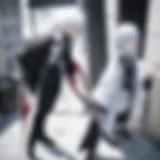In-Depth Analysis of One Punch Man on Amazon Prime
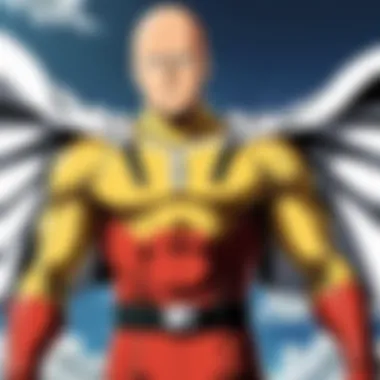

Intro
In the expansive universe of anime, few series have sparked as much intrigue and discussion as One Punch Man. Available on Amazon Prime, this unique blend of comedy and action offers a fresh perspective on the superhero genre, capturing both long-time fans and newcomers alike. It tells the story of Saitama, a seemingly ordinary guy who possesses an extraordinary ability: he can defeat any opponent with a single punch. This seemingly humorous premise, however, runs much deeper, exploring profound themes of boredom, existentialism, and the nature of heroism.
By examining the series through various lenses— including its episodes, character development, and cultural significance—this article aims to provide a comprehensive analysis of One Punch Man. From the impact of its storytelling to the artistry behind its animation, we will delve into key elements that make this show a standout in the anime landscape.
This journey will embrace not just the plot, but also the broader implications and connections that One Punch Man has within the modern context of anime and pop culture.
Join us as we take a closer look at one of today’s defining series, shedding light on why it resonates with audiences across the globe.
Foreword to One Punch Man
Understanding the essence of One Punch Man is fundamental for grasping its impact on the anime landscape today. This series breaks the mold of conventional storytelling within the superhero genre, putting forward a unique twist on what it means to be a hero. Rather than showcasing a powerful protagonist striving against formidable foes, Saitama, the lead character, is overpowered to the point of boredom. This premise alone challenges the audience’s expectations and invites deeper contemplation about heroism, purpose, and the nature of conflict.
Not only does One Punch Man entertain, but it also poses relevant questions that resonate with modern life. In an age where many seek recognition and success, this anime serves as a profound reminder that fulfillment does not always arise from achievement. In approaching this article, one should consider how the show's themes provoke thought about personal ambitions, societal expectations, and ultimately, what it means to be a hero in a seemingly indifferent world.
Engaging with One Punch Man provides a fresh lens through which viewers can assess their own life choices, adding another layer of importance to the series. It’s not just about watching Saitama defeat his enemies with a single punch; it’s about a journey into existential musings dressed up in kickass animation.
Background of the Series
One Punch Man initially debuted as a webcomic created by the artist known as ONE in 2009. Its unique narrative followed the everyday life of Saitama, an unassuming hero who trains rigorously to attain his goal of becoming the strongest. The webcomic quickly gained traction, catching the attention of various publishers. To add to its reach, it was adapted into a manga illustrated by Yuusuke Murata in 2012, who brought striking visuals and refined storytelling to ONE's original concept.
With One Punch Man, fans were not only treated to a fresh take on superhero narratives but also an exploration of what it means to strive for goals that may seem unachievable. By stripping away the traditional embellishments of hero lore, it delivers a poignant commentary not just on conflict, but also on the triumphs and tribulations of everyday life. Its success led to an anime adaptation, first airing in 2015, which further solidified its place in popular culture.
Overview of Amazon Prime's Offering
Amazon Prime has made notable strides in the anime streaming arena, offering viewers access to a diverse selection of titles, including One Punch Man. On this platform, viewers can easily find the series presented with its full spectrum of content. This includes both seasons, packed with enthralling episodes that depict Saitama’s incomprehensible strength juxtaposed against a world riddled with bizarre monsters and villains.
From the perspective of convenience, Prime's user-friendly interface allows fans to navigate quickly through episodes and engage with various supplementary content, enhancing the viewing experience. Moreover, the platform often provides options for both dubbed and subbed versions, catering to a broader audience across different language preferences.
One significant advantage of Amazon Prime’s offering is its commitment to streaming quality. With options for HD viewing, many fans report a satisfying visual experience, crucial for capturing the stunning animation and intricate details presented in this series.
In terms of availability, it's vital to highlight that One Punch Man can be easily accessed in multiple regions, making it a great choice for international audiences eager to delve into the series without undue restrictions. With the perks of Amazon Prime’s subscription model, viewers can enjoy this acclaimed series while also exploring a wider array of anime titles available.
"Accessibility is a key element in expanding the reach of anime, and Amazon Prime's diverse offerings exemplify this commitment."
Choosing the right streaming platform to watch One Punch Man can significantly enhance your encounter with the series, underscoring its importance in the current anime distribution landscape.
Plot Synopsis
In understanding the broader narrative of One Punch Man, the importance of the plot synopsis can't be overstated. It provides a framework in which viewers can comprehend the series' blend of humor, action, and existential philosophy. The plot serves as a gateway, drawing in the audience and allowing them to connect emotionally with the characters and situations presented. By outlining the essential elements of the storyline, readers can better appreciate the creativity and depth behind the comedic façade of the series.
Preamble of Saitama
Saitama, the protagonist, embodies a unique archetype in the anime world. Unlike traditional heroes who struggle against challenges, Saitama's overwhelming power makes him astoundingly indifferent to most conflicts. His character raises questions about the nature of heroism and the sense of fulfillment that comes with it. This ordinary-looking man, capable of defeating any foe with a single punch, often finds himself battling boredom rather than villains. His journey from an ambitious hero to a languid figure questioning the meaning of it all encapsulates the series' satirical take on what it truly means to be a hero. The humor tied to his existential crisis adds layers, enticing viewers to reflect on their own aspirations and the realities of attaining them.
Villains and Conflicts
The villains in One Punch Man are not just mere obstacles; they represent deeper thematic elements that challenge Saitama and the world around him. Each villain introduces complex dynamics that keep the narrative fresh and exciting, from the childlike glee of the villainous Boros to the relentless ambition of Garou. These antagonists showcase diverse motives—some driven by vengeance, others by ideology—and provide a counterpoint to Saitama's indifferent outlook. The conflicts are not merely physical battles but ideological showdowns that question the values of society and the essence of good versus evil.
- For example, Garou, often dubbed the "Hero Hunter," flips the stereotype by portraying a character who seeks to dismantle the very system that idolizes heroes, providing insight into the sometimes blind nature of hero worship.
- Moreover, the scale of conflicts escalates dramatically, reflecting the animation's ability to showcase growth both in Saitama’s character and in the threat level posed by each villain.
Key Arcs and Developments
The series is built on pivotal arcs that drive the storyline forward and shape character development. Each arc is meticulously crafted to layer complexities onto the narrative, leading to moments of humor, tension, and occasional poignancy. The Hero Association arc, for instance, introduces a myriad of heroes, each with their own skills and personas, contributing to the overall richness of the world-building.
- The Alien Invasion Arc expands the universe further, challenging even Saitama's overwhelming power and forcing him to confront foes that threaten the cosmos.
- Furthermore, the evolution in Saitama’s relationships, especially with Genos, highlights emotional growth and camaraderie amidst the absurdity of their world. This arc not only explores their master-disciple relationship but probes Saitama’s ability to connect, which is something he often struggles with.
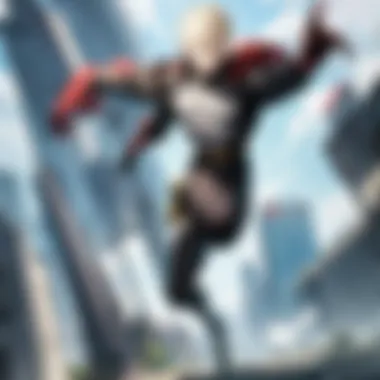

In summary, the Plot Synopsis of One Punch Man serves as an essential tool for viewers to navigate its multifaceted narrative. It underscores the innovative approach that the series employs in juxtaposing humor with serious themes, laying the groundwork for deeper thematic exploration and character analysis.
Character Analysis
Understanding the characters in One Punch Man is crucial to appreciating the narrative and thematic depth of the series. These characters are not mere vessels for action and humor; they serve as conduits for exploring themes like existential dread, the meaning of heroism, and the societal perceptions of power and strength. Each character embodies unique traits and experiences that enrich the viewing experience and provide viewers with varied points of identification, making the show resonate on multiple levels. Below, we delve into the central figures of the story.
Saitama: The Antihero
Saitama, often referred to as the epitome of an antihero, presents a fascinating contradiction in character development. While he possesses overwhelming strength, his struggles are inward rather than outward. This character illustrates the absurdity of a hero who accomplishes his goals too easily, resulting in existential boredom and a profound sense of disconnection from others. His journey raises compelling questions about the nature of fulfillment and the burdens that come with extraordinary talent.
Saitama embodies the classic trope of the everyman, yet his abilities set him apart from typical heroes. People often overlook him, both in and out of action, revealing the irony woven into his character. He serves as a critique of traditional heroic narratives where the hero must strive against insurmountable odds. Instead, Saitama’s battles, while technically thrilling, often end before they even begin, providing a fresh take on what a 'hero' truly embodies.
Supporting Characters
The supporting cast adds layers to the narrative and highlights various aspects of heroism.
Genos
Genos, the enthusiastic cyborg, showcases the relentless pursuit of improvement and vengeance. His key characteristic is his unwavering dedication to becoming stronger and avenging his fallen mentor. This ambition contrasts sharply with Saitama's nonchalance towards heroism. Genos symbolizes the archetypal hero, always striving, always learning, which serves as a foil to Saitama’s lazy acceptance of his status.
His unique feature lies in his integration of machine and human qualities, which offers an intriguing exploration of identity and purpose in a world filled with heroes. While Genos represents hope and aspiration, he often faces the drawbacks of blind ambition, which can lead to reckless decisions and relentless pressure.
Garou
Garou, often dubbed the “Hero Hunter,” exemplifies the complexity of villainy in One Punch Man. His character is grounded in a profound philosophy regarding strength and the nature of monsters versus heroes. He presents an anti-heroic perspective that challenges the conventional views of good versus evil. Garou’s key characteristic is his belief in empathy towards monsters, showcasing the gray areas in moral dilemmas.
One of Garou’s unique features is his evolution from a mere villain to a character that piques interest for his multifaceted motivations. This complexity allows audiences to engage deeply with his journey, raising questions about what it truly means to be “good” or “evil.” Yet, Garou’s pursuit of strength often blinds him to the consequences of his actions, leading to chaotic outcomes.
Mumen Rider
Mumen Rider represents the spirit of perseverance against all odds. He may lack superhuman abilities but compensates with an indomitable will to fight for justice. His key characteristic is his courage, embodying the notion that heroism is not defined by strength alone but by the willingness to stand up for what is right.
Unique to Mumen Rider is his relatability; he is the everyday person thrust into battle, underscoring the idea that anyone can be a hero in their own right. His challenges reflect the harsh realities of life, and while he often finds himself overmatched, his resilience serves as an inspiration. However, Mumen Rider also illustrates the limitations of human capability against overwhelming odds, raising essential discussions of heroism versus practical reality.
Character Relationships
Character relationships in One Punch Man bolster the narrative and contribute to deeper themes.
Saitama and Genos
The bond between Saitama and Genos highlights an intricate mentor-mentee dynamic. Genos looks up to Saitama as an ideal and strives for his recognition. This relationship adds depth, illustrating contrasts in motivation and expectation—Genos seeks validation, while Saitama yearns for inner peace from his overwhelming abilities. Their interactions often evoke a blend of humor and poignant reflection on the nature of mentorship.
Advantages of this relationship include the exploration of loyalty and admiration, pivotal elements in storytelling. The heartfelt moments contrast sharply with the absurdity of their world, reminding viewers that personal connections can exist even in fantastical settings.
Hero Association Dynamics
The Hero Association serves as a microcosm for societal structures and the complexities of classification within heroism. It embodies institutional power and the politics of recognition versus merit. The dynamics within this association present themes of competition and recognition, where the worthiness of heroes is constantly evaluated.
This unique feature of the association allows for a rich exploration of the bureaucratic and often flawed nature of systems that govern perceptions of heroism. However, it also underscores the often arbitrary delineations between those regarded as heroes and those who are not, inviting viewers to question the systems they participate in.
Themes and Messages
In the intricate landscape of anime, One Punch Man carves out a significant niche through its exploration of various themes and messages that resonate deeply with its audience. The reflection on existence, the nuanced portrayal of heroism, and the pointed societal commentary are not just threads woven throughout the narrative; they form the very fabric of the series itself. These elements engage the viewer at multiple levels, prompting meaningful contemplation about our own lives and society at large, which can be both rewarding and thought-provoking.
Existential Reflections
Existential queries are interspersed throughout One Punch Man, challenging the audience to reflect on the nature of life and purpose. Saitama, the seemingly indomitable hero who defeats foes with a single punch, finds himself grappling with an overwhelming sense of ennui derived from his extraordinary powers. This boredom leads to questions like: What does it mean to be a hero when challenges come so easily? Moreover, the series invites viewers to explore the absurdity of existence, a theme rooted deeply in philosophy.
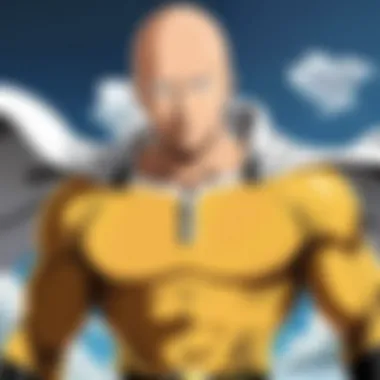

Saitama’s journey, while comedic on the surface, echoes the philosophical musings of thinkers like Albert Camus and existentialists who discuss the absurd. His encounters with various villains serving as reflections of his own struggles emphasizes that struggles and challenges are intrinsic to finding meaning.
"When we have everything at our fingertips, could we be the architects of our own apathy?"
Through Saitama’s eyes, the audience confronts a crucial dilemma: does power equate to fulfillment? This theme resonates particularly among those who may feel unchallenged in their own lives, serving as a mirror to viewers' daily routines.
The Nature of Heroism
One Punch Man intricately redefines what it means to be a hero. The show challenges traditional archetypes by presenting Saitama, an anti-hero who lacks the typical motivation of grandeur or glory. Instead, he seeks something as simple as a worthy opponent. Unlike typical heroes who rise upon the pedestal of honor, Saitama’s journey suggests that heroism is often draped in layers of complexity.
Furthermore, the series showcases a diverse array of heroes—from the self-absorbed and glory-seeking to the genuinely altruistic—illustrating that heroism takes many forms. For example, characters like Genos, who seeks to avenge his family, represent a more traditional motivation for heroism, empowering the discussion around what truly drives individuals to become heroes.
This deconstruction encourages the audience to reconsider their perceptions of heroism and challenges them to think about who they admire and why. In this era of social media, where heroes are often idealized, One Punch Man sparks an important dialogue on authenticity in heroism, shedding light on the multifaceted nature of those we regard as heroes in real life.
Societal Commentary
Broader societal observations underscore the narrative of One Punch Man, skillfully merging humor with critique. The depiction of the Hero Association reflects real-world structures, illustrating bureaucracy and the often arbitrary nature of recognition and success. Viewers are prompted to consider the disparity between genuine heroism and the superficial accolades that society offers.
Moreover, the series addresses issues such as consumerism, fame, and the search for identity in a world that rewards superficiality rather than genuine strength or effort. Villains in the series often symbolize societal failings, suggesting that the monsters we face are sometimes a reflection of our own vices, fears, and shortcomings.
This commentary opens a window for discussions about how society sees success and power. It challenges the prevailing idea that being recognized by society is synonymous with worth, encouraging audiences to delve deeper into what it means to make a positive impact.
In this sense, by framing the superhero narrative within the boundaries of reality, One Punch Man offers a mirror to society, provoking thought about our values, motivations, and the true essence of heroism.
These themes, intertwined with humor and action, establish One Punch Man not just as an entertaining watch but as a rich text for analysis—an exploration into the very core of who we are and what we aspire to be.
Animation and Art Style
The importance of animation and art style in One Punch Man cannot be overstated. It effectively intertwines with the narrative, enhancing viewer engagement while also mirroring the series' themes and character portrayals. This section dives into the visual craftsmanship that makes this anime a standout in a saturated market. From dynamic fight sequences to subtle character animations, the art style acts as a crucial vehicle for storytelling. The design choices play off the motifs of absurdity and existentialism, often reflecting the main character's journey in a way that resonates deeply with audiences.
Visual Aesthetics
The visual aesthetics of One Punch Man play a paramount role in its identity. The character designs are distinctive, from Saitama's plain visage to the exaggerated features of the villains. Such contrasts mirror the series' humor and critique of typical superhero narratives. The color palette often swings between muted tones and vibrant splashes during action scenes, compelling viewers to feel the emotional weight of each moment.
Each setting is crafted with meticulous attention, whether it be the bustling metropolis where heroes and villains collide or the serene landscapes that border Saitama's world. This careful crafting of visual elements isn’t just for spectacle; it builds a cohesive atmosphere that draws viewers into the narrative world, making the experience immersive and engaging.
Impact of Animation Techniques
Animation techniques utilized in One Punch Man set a benchmark for quality in the anime genre. The fluid movement during combat scenes showcases not only technical skill but also the emotional intensity of the characters involved. Key moments are punctuated by surreal visuals that enhance the comedic tone yet don't detract from the tensions at hand. The use of split-second slow motion in climactic battles creates a powerful juxtaposition, allowing viewers to savor every punch, twist, and turn.
Moreover, the interplay of 2D and 3D animation techniques adds a layer of depth that many series often overlook. This fusion grants a sense of weight and realism to the action that is both thrilling and visually appealing. Through these animation choices, One Punch Man transcends mere viewing; it becomes a visceral experience that leaves a lasting impression.
Consistency Across Seasons
From its inception, One Punch Man has maintained a high standard of animation consistency across its seasons. The shift in production studios from Madhouse to J.C. Staff in the second season raised some eyebrows, yet the core quality remained, proving that the essence of the series was intact. Viewers were treated to familiar visual cues and signature action sequences that had set the bar so high in the first season.
Despite the challenges that come with changing teams, the character designs and action sequences have not faltered. Each season still leverages its predecessors' successes while introducing fresh visuals that keep longtime fans engaged. This sense of continuity reassures audiences that they're in for the same exhilarating ride, even as the narrative evolves.
"Animation is not just about movement; it's about emotion, storytelling, and connecting with the audience."
In sum, the animation and art style in One Punch Man serves as more than mere decoration. It’s a fundamental part of the storytelling fabric, enriching the viewer's experience and highlighting the series' underlying commentary on heroism and the absurdities of life. With such remarkable attention to visual detail, it’s no wonder that One Punch Man remains a beloved staple in the world of anime.
Reception and Impact
The impact of a series like One Punch Man transcends mere viewership; it echoes through critical circles, resonates with audiences, and shapes cultural conversations. In this section, we unearth the layers of its reception, illustrating the pivotal role it plays in understanding its significance in today’s anime landscape. Critical acclaim, audience rapport, and cultural influence are the tripartite lenses through which we shall scrutinize the phenomenon that is One Punch Man on Amazon Prime.
Critical Acclaim
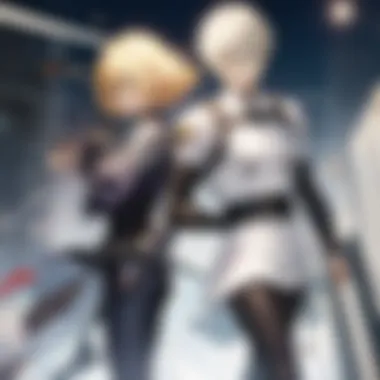

One Punch Man has garnered praise from critics for its blend of humor and action, challenging traditional norms in superhero storytelling. Notably, the animation quality by Madhouse (and later J.C. Staff) has been described as breathtaking. Critics note that the fight sequences, like the explosive showdown between Saitama and Boros, are choreographed with an intensity that raises the bar for animated action.
"The series isn't just a laugh; it’s a statement about the nature of heroism and the futility of excess."
Review aggregators, such as Rotten Tomatoes, reflect an impressive consensus among critics, many doling out perfect ratings. This acclaim isn't merely subjective; it acts as a beacon for newcomers, steering them toward a high-quality viewing experience. Many publications articulate that beyond the surface-level comedic elements, the series invites a deeper reflection on the monotony of modern existence.
Audience Reception
The response from the audience has been nothing short of phenomenal. From its debut, the series developed a dedicated fanbase that spans continents, transcending barriers of language and culture. On platforms like Reddit, fans gather to share their favorite moments, elaborate fan theories, and art that pays homage to the series and its characters. This organic engagement speaks volumes about its relatability.
Fans often point to Saitama’s deadpan demeanor as a mirror reflecting their own existential dilemmas, sparking discourse that extends beyond the lighthearted surface. Audience ratings on Amazon Prime bolster its reputation, with many highlighting the way the series delivers both thrills and laughs in equal measure. Anecdotal evidence suggests that the show has converted viewers unfamiliar with the anime genre, making them avid fans.
Cultural Influence
One Punch Man occupies a unique intersection within popular culture. It has embedded itself in the global anime discussion, influencing both contemporary and future works. Its parody of the superhero genre revitalizes traditional tropes, offering a critique of heroism that today resonates in a world weary of conventional hero narratives.
In recent years, we’ve seen an upsurge in similar anime that echo its themes of disillusionment and irony. Cosplay conventions see One Punch Man characters frequently represented, indicating its footprint on contemporary pop culture.
Moreover, memes drawn from the series—Saitama's blank stare, for instance—have permeated social media, amplifying its reach beyond the average viewer. It has inspired discussions, memes, and even merchandise that celebrate its influences and the cultural conversations it fosters. The essence of Saitama and his struggle against ennui holds a timeless allure, staying relevant in an age where authenticity is prized.
In summary, the reception and impact of One Punch Man serve not just as a reflection of its quality, but as an essential part of the dialogue surrounding modern anime. Its critical acclaim, audience engagement, and cultural significance illustrate why this series remains a cornerstone in the anime genre as available on Amazon Prime.
The Role of Amazon Prime in Anime Distribution
Amazon Prime has carved a niche in the competitive world of anime distribution, making significant strides since its inception. It's not merely about streaming; it’s about transporting viewers into realms of rich narratives and captivating art styles. The importance of this platform is evident for several reasons, including its expansive library, accessibility, and the unique showcases that standardize the viewing experience for fans.
One cannot understate how platforms like Amazon Prime sway the anime landscape. While other services might target specific demographics, Amazon offers a more generalized approach that enables a wider audience to discover anime, even those who might not be avid fans. By packaging popular series like One Punch Man alongside a range of other media, it invites curiosity and exploration. This is crucial for the genre's growth, especially in engaging viewers who may not have considered anime otherwise.
Comparison to Other Streaming Platforms
When buying into the anime experience, Amazon Prime is often compared to heavyweights like Crunchyroll and Funimation. Here’s a closer look at their differences:
- Content Variety: Amazon Prime streams a broader array of series, including original content that sets it apart from niche platforms. While Crunchyroll focuses heavily on anime, Amazon diversifies with live-action shows and movies, thus appealing to varied interests.
- User Interface: Users often comment on Amazon's interface being user-friendly, reducing the hassle of hunting down titles. Compared to Funimation’s separate apps and Crunchyroll’s sometimes confusing catalog, Prime presents a smoother experience.
- Pricing Structures: Amazon Prime's subscription model can be advantageous. With a single membership covering many entertainment needs, viewers might find it economically sensible compared to multiple subscriptions needed elsewhere.
In summary, while Crunchyroll and Funimation are dedicated to delivering anime, Amazon Prime stands out by providing a more comprehensive entertainment package that does appeal to both casual viewers and die-hard fans alike.
Advantages for Viewers
Amazon Prime serves its viewers well with a few notable advantages, making it a strong contender in the anime distribution arena:
- Accessibility: The ease of access can’t be ignored. All you need is a Prime subscription, and several devices can stream content without fuss. It caters to members wanting flexibility and eliminates the need for cumbersome sign-ups on multiple platforms.
- Exclusive Content: Titles unique to Amazon Prime often generate buzz. For example, the platform features exclusive episodes and dubbed content that fans frequently wish to catch.
- Personalization Options: The recommendation algorithms work quite effectively, suggesting new shows based on watching habits. This encourages viewers to venture beyond their usual favorites.
- Offline Viewing: One often overlooked aspect is the option to download content for offline viewing, a lifeline for those on the go or those with unreliable internet connections.
"The role of distribution in anime feels almost as important as the storytelling itself. It shapes access, conversation, and ultimately, the culture around the genre." - Anonymous
In an environment where multiple platforms are vying for attention, Amazon Prime's focus on accessibility and variety makes it a notable player in the anime distribution sphere.
Ending
In wrapping up the exploration of One Punch Man available on Amazon Prime, it’s essential to underscore the series' significance within the anime landscape. This work goes beyond mere entertainment; it's an intricate blend of humor, action, and deep philosophical undertones. As we've dissected its pivotal themes, character growth, and cultural relevance, the article serves as a reflective surface for readers to understand why One Punch Man resonates strongly with audiences across different demographics.
Summation of Key Points
- Unique Narrative Structure: One Punch Man cleverly subverts the typical superhero trope by presenting a protagonist who wins every battle with a single punch. This invites viewers to reconsider what makes a hero compelling.
- Character Dynamics: The interactions between Saitama and supporting characters, such as Genos and Garou, highlight the multifunctional relationships that forge deeper emotional connections with the audience.
- Cultural Commentary: The series provides astute observations on societal values and expectations surrounding heroism in a modern context, challenging conventions of traditional hero narratives.
- Animation Quality: The exceptional artistry and animation techniques elevate the viewing experience, demonstrating how visual storytelling can powerfully complement narrative themes.
By synthesizing these key aspects, readers gain insights into how One Punch Man not only entertains but also invites critical reflection and discussion among peers.
Future of One Punch Man
Looking ahead, the future of One Punch Man appears promising. With ongoing discussions about potential new seasons, adaptations of the manga's later arcs could provide fresh material for both longtime fans and newcomers alike. This anticipation is buoyed by a fervent community, as evidenced on platforms like reddit.com, where enthusiasts share theories and analyses, keeping the momentum alive.
Moreover, the series' unique premise continues to inspire new genres, as seen in emergent works that blend comedy with action in unprecedented ways. As streaming platforms evolve, this phenomenon reinforces One Punch Man’s position as a trailblazer, fostering a culture of critical engagement with anime as a medium. This evolution not only underlines its relevance but also hints at broader implications for the anime industry as a whole.
Overall, One Punch Man, as accessed through Amazon Prime, represents a significant touchstone in contemporary anime that will likely influence storytelling and character development for years to come.
